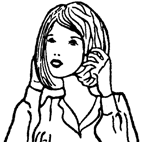“It’s like looking at someone with short hair. We could tell if that person had long hair in the sixties and now has short hair, as opposed to the guy who’s always had short hair since the fifties.”
Peter Gena, in conversation with Morton Feldman
Having first heard parts of Richard Emsley’s for piano series, started in the mid 1990s, I little suspected that these pieces signalled a change in style from his earlier work as an accused member of the British New Complexity School. The austere arrangements of undeveloped points and blocks of sound in for piano start to make a new kind of sense with this background information: the static sound-world of these later works isn’t necessarily a disavowal of the B.N.C.S.’s frantic activity, but a fresh approach to some of its values. Where the B.N.C.S.’s notorious ‘black page’ approach to notation asymptotically aspires to re-create musicianship in free flow, Emsley’s unadorned sounds can be heard as emulating the interior processes of musicians, in reflective contemplation of the stuff of their art.
Still/s is a cycle of twenty-four pieces for five musicians, composed between 2002 and 2019. On Saturday, they were played in their entirety for the first time by Apartment House as part of Music We’d Like To Hear. There were two concerts, of about two hours each, to get through the whole set. The first hint of Emsley’s approach is that each piece is for only one to three of the five instruments (the musicians here were Mira Benjamin, violin; Anton Lukoszevieze, cello; Heather Roche, clarinets; Nancy Ruffer, flutes; Kerry Yong, piano). The series was originally conceived as a counterpart to artist Joan Key’s painting, the juxtaposition of repeated shapes and muted, near-white colours finding an analogy in Emsley’s music.
These are not pieces to be approached with a restless mind, unless one is seeking to silence the internal monologue. Many of the pieces stick to one or two pitches, echoed back and forth between instruments. The apparent stasis is at odds with an inherent instability in each piece, as Emsley notates his isolated sounds in aperiodic settings, frustrating any definable pattern that might otherwise emerge. Other pieces set out gamuts of notes to be played in irregular permutations; more rarely, a piece will be made up of a brief motive heard in variations. Successive pieces will seem to vary only in instrumentation, before the next abruptly introduces something entirely anomalous: simple sounds presented in a way that is anything but simplistic.
In retrospect, the series unexpectedly reveals a microcosm of musicianship, with minor forays into studies in timbre, intonation, extended techniques and rhythm. With their focus and their awareness of the potential inside each unprepossessing piece on paper, the musicians of Apartment House steadily zoomed in on this microcosm, expanding on each hidden facet while remaining as near-monochrome as possible. What impressed most was the use of instrument tone and register, with flute and violin, clarinet and cello at times blending almost indistinguishably, at other moments coming close to mimicking each other, alto flute against cello harmonic, E-flat clarinet in just the right place to match the muted violin.
